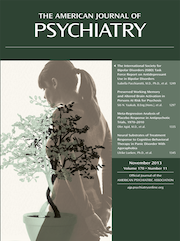Although many patients with panic disorder and agoraphobia respond well to treatment, for others the response is unsatisfactory. Investigating why some respond well and some do not is the only way that we can ever hope to improve treatment for nonresponders. Brain imaging studies have identified many key neuronal circuits in panic disorder. A large co-operative study in this issue of the
Journal, conducted by Lueken et al. (
1) and carried out across several German psychiatric centers, has now monitored how activity in these circuit changes are involved in panic attacks with agoraphobia during treatment. The authors’ efforts to develop a multisite consortium with matched scanners and clinical programs made their study possible. Studies from this group and others have suggested that a network involving the coupling of the prefrontal cortex and amygdala plays a role in panic attacks with agoraphobia, as does hippocampal activity. In comparing responders to a cognitive-behavioral program with nonresponders, Lueken et al. were able to show that “patients who did not respond to treatment exhibited enhanced activation in the pregenual anterior cingulate cortex, the amygdala, and the hippocampus during safety signal processing compared with responders” (
1). Nonresponding patients activated a circuit that suggested danger in response to a safety signal, so instead of getting the messages that “things are okay,” they continued to register mild danger signals. Thus, for these patients, the cognitive exposure appears to partially reinforce rather than diminish the feeling of danger, through a misinterpretation of the safety signal. Looking closely at the data, there is a continuum across these responses rather than two discrete groups of clear responders and nonresponders. This is also the case clinically, since the 50% dividing line for response or nonresponse to cognitive therapy did not lead to two distinct groups. Rather, the patients exhibited a continuum of therapeutic responses. Thus, there are some very good and very poor responders at the two extremes, where these differences are most apparent, but there are also many patients in the middle who receive some benefit and some normalization of neuronal activity. Clinically, this suggests, as the authors note, that cognitive-behavioral therapy may be appropriate for a majority of patients, since even most nonresponders showed changes in the right direction following therapy.
The data in this study are similar to those in a previous positron emission tomography study that found the most elevated glucose uptake to be in the amygdala, the hippocampus, and the thalamus in patients with panic attacks with agoraphobia, also indicating that the fear network is activated in this condition (
2). This fits reasonably well with the present study, which demonstrated a fear network involving the hippocampus and amygdala. The negative coupling seen in this study between the anterior cingulate cortex and amygdala suggests that cortical inhibition of the fear response is central in avoiding a panic reaction. Figure 2 of the article illustrates that nonresponsive patients exhibit decreased activation of the anterior cingulate cortex (i.e., the anterior cingulate cortex does not signal the amygdala to shut down). Hippocampal involvement also appears to be essential for a good therapeutic response. The hippocampus is involved in the recall of outcomes (i.e., contingency, so that the patient remembers what the safety signals are when they appear again). Thus, hippocampal activation drives an awareness of the connection between the stimulus and an unpleasant or pleasant result in the past, and increasing its activity should, and appears to, lead to a reduction in anxiety due to contingency awareness.
What clinical utility can we achieve from this type of study? We benefit enormously in designing therapies for psychiatric illnesses if we know the circuits that mediate the symptoms that we are trying to alleviate. In the case of depression, knowledge of the circuits has directly informed the deep brain stimulation trials currently under way, and, as Lueken et al. point out, methods currently available to modulate circuit activity, such as transcranial magnetic stimulation, may be usefully applied in a targeted fashion to conditions such as panic disorder with agoraphobia if we know where and what we would like to alter. Because we are better able to modulate brain activity, this type of information will become ever more useful. Targeted psychopharmacology is also an area that, as it is developed, will depend upon knowledge of the pathological circuits leading to disturbed behavior. An imaging profile to determine whether a particular patient is a candidate for cognitive therapy may not be practical, and even poor responders receive some benefit. However, the imaging data do point out that poor responders may not respond well because they do not pick up or remember safety signals, which good responders are able to detect and remember. Therapists aware of this potential issue may be able to adjust their approaches accordingly for poorly responding patients.

